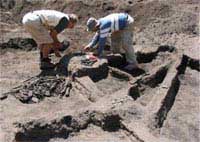Scientists believe they have discovered the remnants of the lost Tambora civilization in Indonesia. This entire ancient society was wiped out in 1815 by the largest volcanic eruption in history.
 |
|
Haraldur Sigurdsson at the excavation site on Mount Tambora. (Photo: AP) |
The disaster from Mount Tambora on April 10, 1815, buried all living organisms on Sumbawa Island beneath layers of ash and debris.
Following ground-penetrating radar waves, researchers from the United States and Indonesia uncovered a trench where they found remnants of a thatched house, pottery, bronze items, and the skeletons of two individuals, all located beneath layers of sediment from the volcanic eruption.
Volcanologist Haraldur Sigurdsson from the University of Rhode Island estimated that around 10,000 people lived in the town when the volcano abruptly erupted, similar to the eruption that buried the Roman city of Pompeii.
The fury of Mount Tambora released 400 million tons of sulfur dioxide into the atmosphere, causing a global temperature drop and creating a period that historians refer to as “The Year Without a Summer“. Farms in Maine, USA, were devastated by a frost that destroyed crops in June, July, and August. In France and Germany, vineyards and corn harvests were ruined, leading to stalled harvests.
The civilization on Sumbawa Island has intrigued researchers since a Dutch and British expedition visited the area in the early 1800s. They were astonished to hear a language that was unlike any spoken in Indonesia. Some scholars believe this language resembles those in Indochina more closely. However, shortly after the first Europeans arrived in Tambora, this entire society was obliterated.
“The volcanic eruption erased that language. It is truly unfortunate. But we are trying to give these people a voice again by excavating them,” Sigurdsson stated.
What researchers have found suggests that the residents of Tambora originated from the Indochina region or had trade connections with that area. For instance, the pottery discovered closely resembles products from Vietnam.
John Miksic, an archaeologist at the National University of Singapore, reviewed the video footage of the excavation and believes that Sigurdsson’s team has indeed found the settlement destroyed by the volcano. However, he is skeptical that the Tambora people came from Indochina or spoke a language from that region. If Vietnamese pottery made it to this island, it could have been due to trade between merchants.
During the excavation, Sigurdsson’s team also found the charred remains of a woman who may have been in her kitchen. A melted machete and a bottle were found nearby. The remains of another individual were discovered just outside, possibly at the entrance.
M.T.


















































